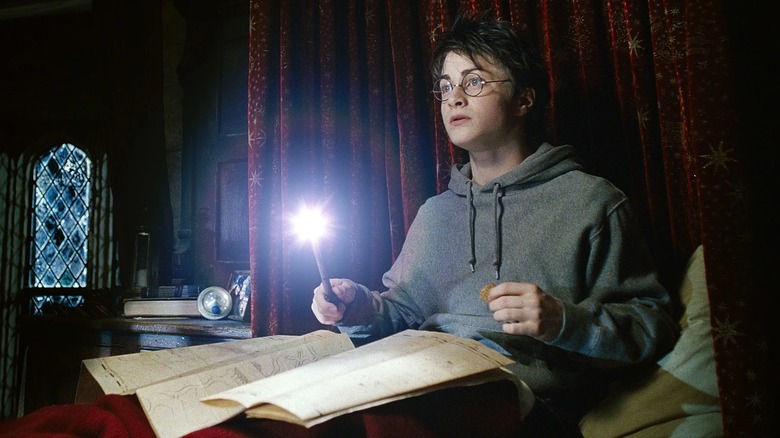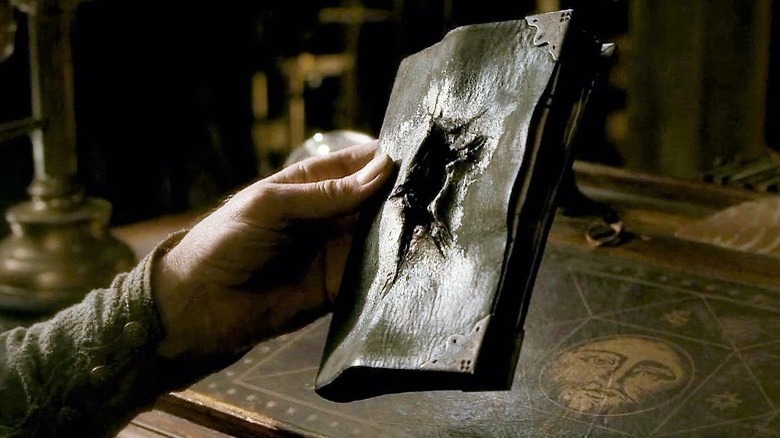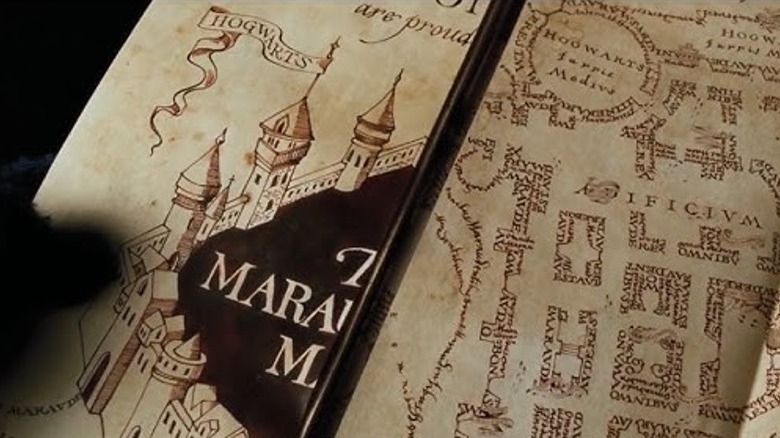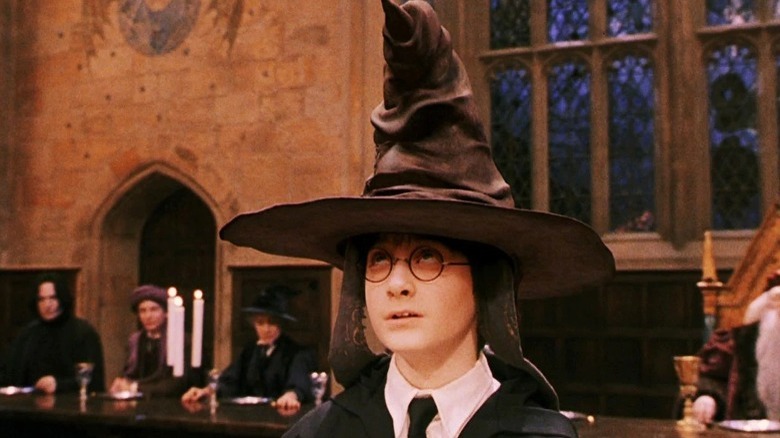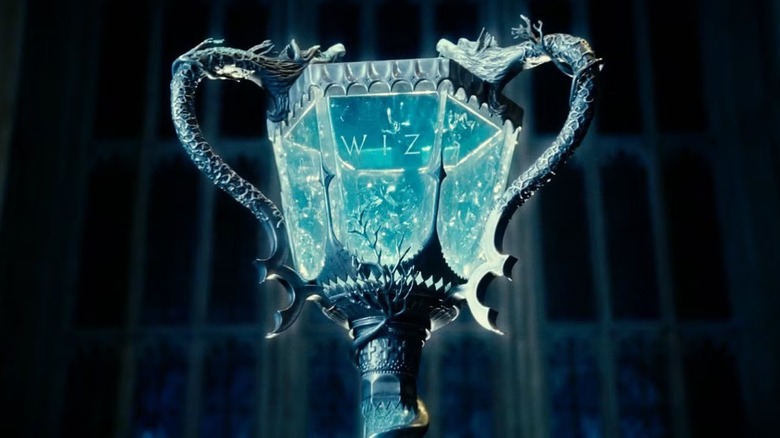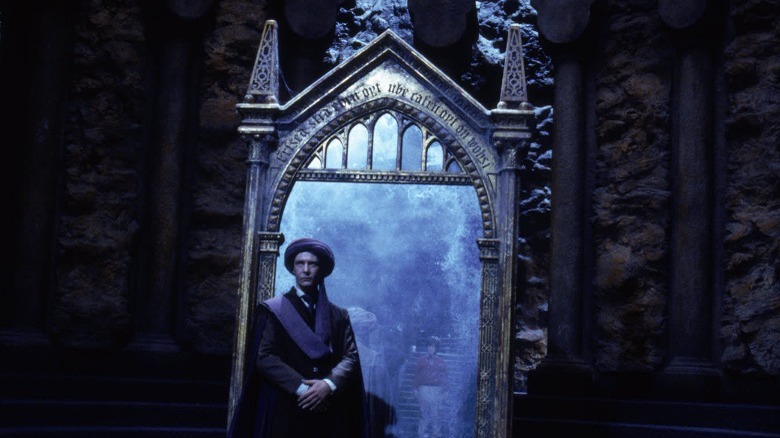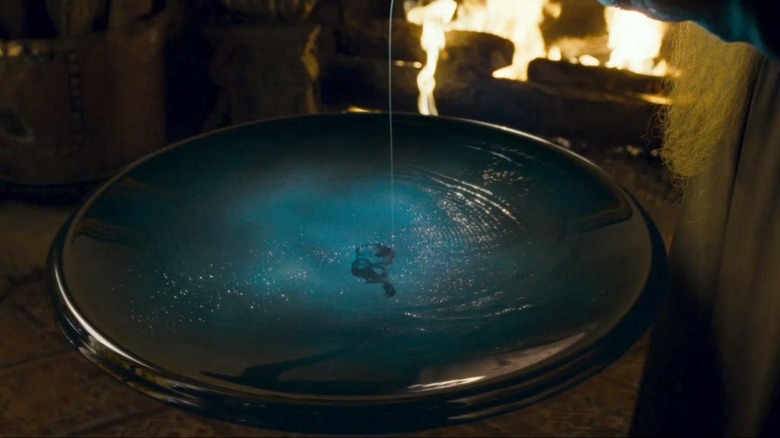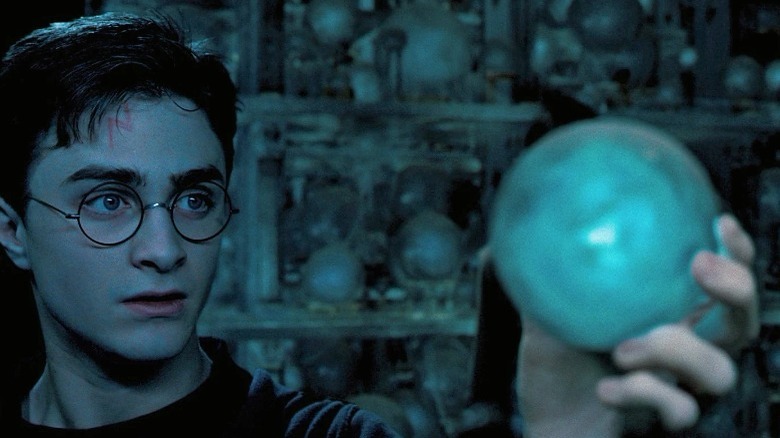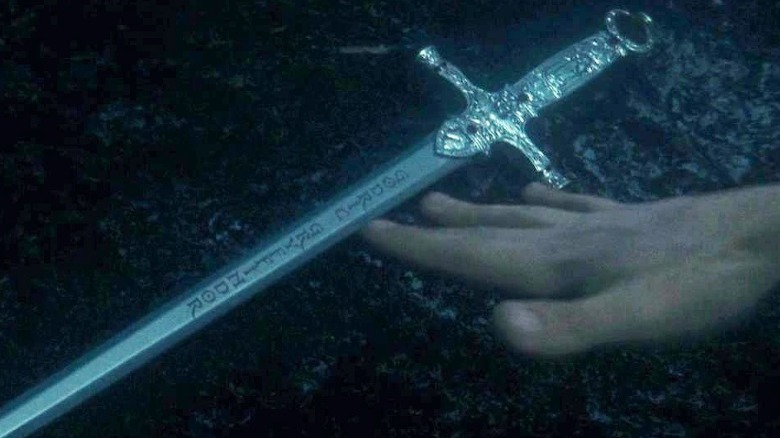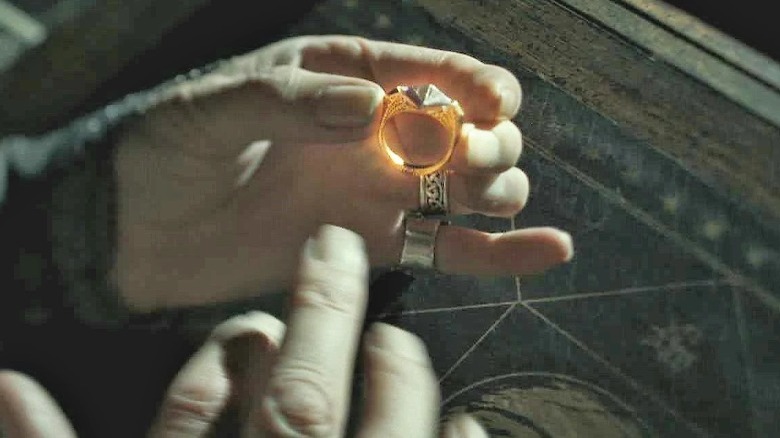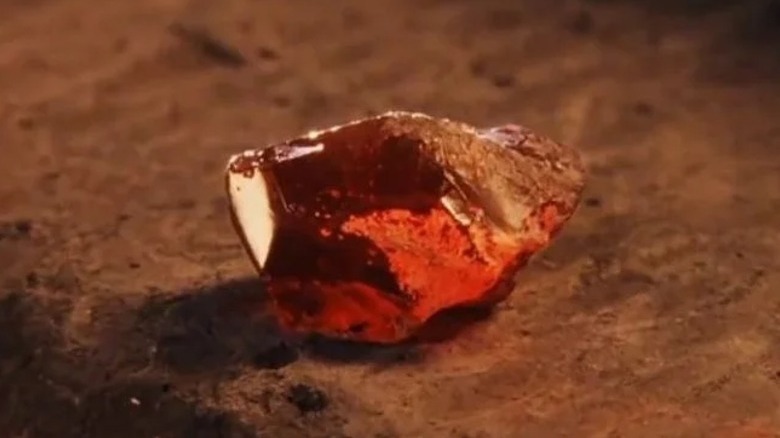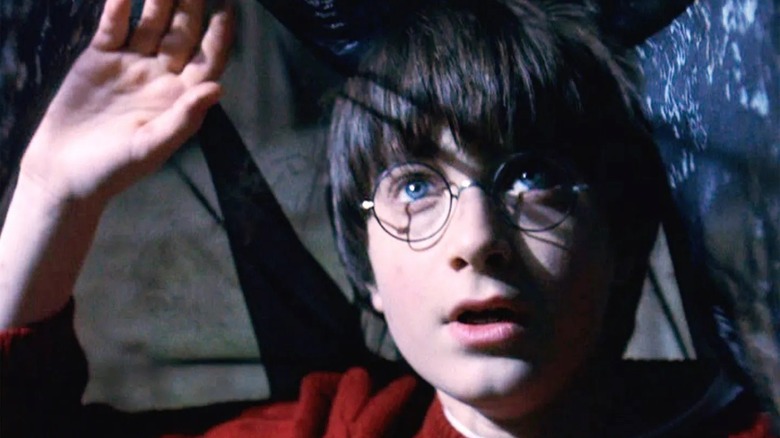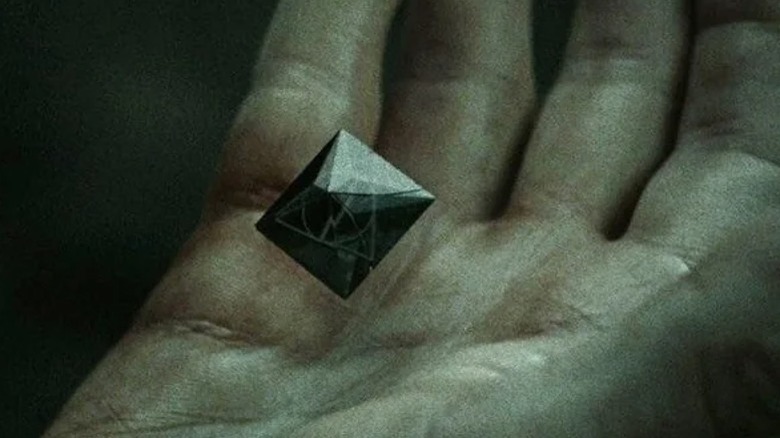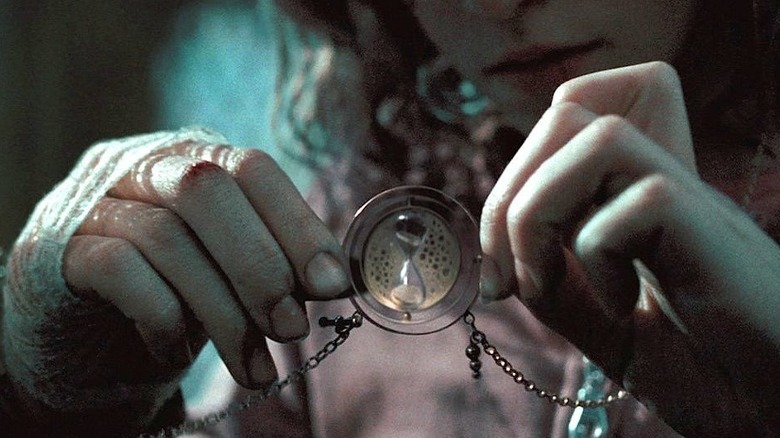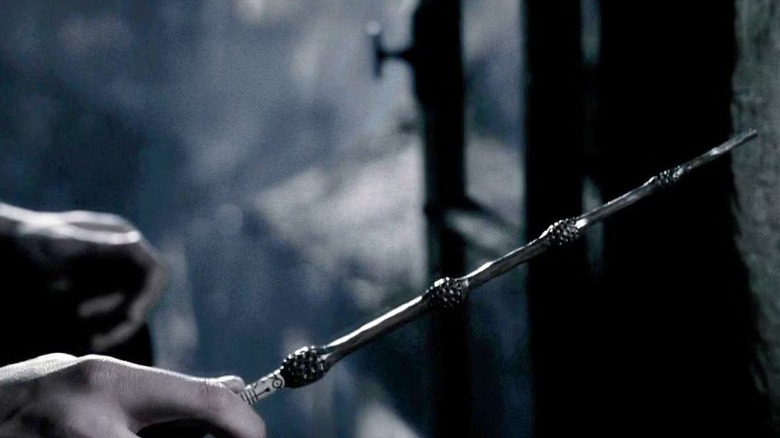The Most Powerful Magical Objects In Harry Potter, Ranked
The "Harry Potter" series is filled to the brim with magical artifacts, objects, and devices. Of course, that isn't a huge surprise given that it's set in a world where wizards and witches exist in secret and much of the action takes place in Hogwarts School of Witchcraft and Wizardry, a treasure trove of magical items. While the actions and magical abilities of the characters normally play the biggest role in the story, there are some extremely powerful magical items that are just as important to the overall arc. In fact, a few of these objects are responsible for some of the most heartbreaking moments in the "Harry Potter" franchise. For this list, we're ranking the most powerful magical objects in the wizarding world and explaining exactly what they are capable of.
14. Tom Riddle's Diary in Harry Potter and the Chamber of Secrets
Officially known as T. M. Riddle's Diary, but informally called simply Tom Riddle's Diary, this magical item first appears in "Harry Potter and the Chamber of Secrets." In the novel and film, it first appears to be a blank journal with no magical power. Few people are aware of its true nature, so when Lucius Malfoy passes it on to an unwitting Ginny Weasley, she begins writing in it without any caution.
Soon after the young witch starts using it, the diary exerts its influence to force her to open the Chamber of Secrets and release the Basilisk on the unsuspecting Hogwarts students. This is due to the fact that the diary is not only imbued with dark curses, but also houses a part of Lord Voldemort's soul, instilling it with his personality.
As a Horcrux, the diary allows Ginny to talk directly with Tom Riddle from the time he was a student at Hogwarts, and it absorbs the lifeforce of those using it, creating a physical manifestation of Riddle. While possessing a victim, Riddle's persona could even transfer powers, such as the ability to speak Parseltongue. Harry destroys the diary with a Basilisk fang (the magical creature's venom is one of the few substances capable of eradicating Horcruxes) at the end of the second "Harry Potter" movie.
13. The Marauder's Map in Harry Potter and the Prisoner of Azkaban
For those who don't know the magical words to activate the Marauder's Map from "Harry Potter" ("I solemnly swear that I am up to no good"), this item would look like an ordinary piece of blank parchment paper. But for the initiated, this is actually an incredibly powerful object that proves super useful to Harry, Ron, and Hermione.
Created by Remus Lupin, Sirius Black, Peter Pettigrew, and James Potter under the aliases Moony, Padfoot, Wormtail, and Prongs, the map shows an almost complete floor plan of Hogwarts, along with all of its inhabitants. It eventually passes into the hands of Fred and George Weasley (they stole it from Filch's office), who then give it to Harry during the events of "Harry Potter and the Prisoner of Azkaban."
What makes the Marauder's Map such a powerful magical item is its comprehensive nature. It maps almost every room, corridor, and location within the Hogwarts grounds, with the exception of a handful of secret areas. It is also able to track everyone within the boundaries of the school, regardless of whether they are using an invisibility cloak, potions, or other magical ways of hiding.
12. The Sorting Hat in Harry Potter and the Sorcerer's Stone
The Sorting Hat is one of the first magical items that readers and viewers get to see, with it being introduced early on in "Harry Potter and the Sorcerer's Stone." For Muggle-born witches and wizards, it is also among their first experiences of magic at Hogwarts, as the hat plays an integral role in the Sorting Ceremony. As part of the event, the youngsters put on the Sorting Hat, which then decides which House they will join.
The Sorting Hat is no ordinary price of clothing: It is sentient and able to read the thoughts of those who are using it via Legilimency. It's able to understand their motivations and personality traits, sorting them into the House that best suits each individual. The Sorting Hat can also speak out loud or directly into the mind of the user, and even composed songs to sing at the start of term feast. It was previously owned by Godric Gryffindor, with all four of Hogwarts' founders placing enchantments on it to provide the object's unique capabilities.
11. Portkeys in Harry Potter and the Goblet of Fire
Portkeys are essentially items that allow for near-instantaneous travel between two locations. They come in two distinct versions that are activated in different ways. The first will transport the user upon the item being touched, taking them to a predetermined location. The second is a timed Portkey that is set to activate at a specific time and will carry along anyone who is touching it at that time. It is also possible to set Portkeys to act as a two-way travel system, returning a person back to where they came from with a second touch.
Portkeys are usually commonplace items like boots, brooms, and coat hangers — things that are likely to go unnoticed. The most famous example of a portkey is the Triwizard Cup. In "Harry Potter and the Goblet of Fire," it's supposed to transport the winner of the Triwizard Tournament out of the maze in the final task, though it's been tampered with by Barty Crouch Jr. and instead sends both Harry and Cedric Diggory straight to Voldemort, leading to the murder of the latter. This proves that, while they're mundane by nature, Portkeys can be among the most dangerous of magical items when in the wrong hands.
10. The Mirror of Erised in Harry Potter and the Sorcerer's Stone
The Mirror of Erised appears in "Harry Potter and the Sorcerer's Stone" when Harry discovers it while exploring Hogwarts using his invisibility cloak. Upon looking into it, the young wizard sees a reflection showing him with his late parents, Lily and James. Harry subsequently visits the mirror many times, becoming obsessed with the idea of being able to see his mother and father. Only a warning from Albus Dumbledore is enough to dissuade Harry from continuing to seek out the magical artifact; the wise headmaster explains that "men have wasted away before it, not knowing if what they have seen is real, or even possible."
That's because the Mirror of Erised shows those who gaze upon it their deepest desire, reflecting back what they most want in the world. As such, using the mirror can lead to a fixation that may last days, months, or even years. Exactly who created the Mirror of Erised and why isn't clear. The reason for it being at Hogwarts isn't even known, but it found a home at the school at some point before Harry stumbled upon it. Dumbledore modified the mirror with enchantments to allow it to hide the Sorcerer's Stone, making it so only someone who did not seek to use the stone's powers would be able to retrieve it.
9. Pensieves in Harry Potter and the Goblet of Fire
A Pensieve is an extremely rare magical item that allows a person to experience faithfully recreated memories. First appearing in "Harry Potter and the Goblet of Fire," Pensieves go on to play a more prominent role in the later novels and films. They essentially act as a playback device, allowing wizards and witches to re-live extracted memories from a third-person perspective at any time. Dumbledore uses the Pensieve in his office to organize his thoughts, a process that the headmaster tells Harry makes it "easier to spot patterns and links."
Pensieves are usually ornately carved and decorated with magical symbols. Memories, which take on a strange silvery form when extracted, are placed within the basin and a user will then submerge their head in the liquid to experience the memory exactly how it originally happened. The recreation is so accurate that the Pensieve can show things that a person may have not even noticed at the time they occurred. Although useful, Pensieves are also open to abuse as they allow anyone to view memories, possibly exposing secrets or deeply personal thoughts to malicious individuals.
8. Prophecies in Harry Potter and the Order of the Phoenix
Prophecies are a strange form of magic in the world of "Harry Potter." They are essentially predictions made by a Seer, a person who specializes in magic that allows them to see into the future. Often using somewhat vague language that can be interpreted in many ways, these prophecies are kept in physical form in unassuming glass orbs that contain ghost-like wisps of smoke. Many prophecies are held within the Ministry of Magic in a secret location known as the Hall of Prophecy, a restricted area on Level 9 of the Department of Mysteries. They're labeled with information about who made the prophecy and who it concerns.
The mysterious nature of prophecies and the fact that they can be easily misunderstood means that they can cause great harm in the wizarding world. A good example of this is Sybill Trelawney's first prophecy, which suggested a boy would be born in the near future who would have the ability to defeat Lord Voldemort. Trelawney said that the child would be "born to those who have thrice defied him, born as the seventh month dies." This led to Voldemort killing Lily and James Potter believing the prophecy referred to Harry, setting in motion the events that led to his eventual downfall.
7. The Sword of Gryffindor in Harry Potter and the Chamber of Secrets
As the name suggests, the Sword of Gryffindor is a bladed weapon that was owned and used by Godric Gryffindor, one of the founders of Hogwarts. It was made by goblins from pure silver and is decorated with a few rubies (which is the stone used in Gryffindor's House Cup hourglass). Making its first appearance in "Harry Potter and the Chamber of Secrets," the sword is over a thousand years old and is one of the most powerful objects in the wizarding world — so much so that goblins were determined to have it returned to them as the creators of the weapon.
Thanks to the skill of the goblin silversmiths and the enchantments placed upon it, the Sword of Gryffindor is highly capable. For one, it's able to absorb abilities from substances and items it comes into contact with. For example, after Harry used it to kill the Serpent of Slytherin, it took on some of the properties of Basilisk venom and became able to destroy Horcruxes. The sword appears to worthy Gryffindors in times of need, which comes in handy on more than one occasion as our heroes try to stop Voldemort.
6. Horcruxes in Harry Potter and the Half-Blood Prince
A Horcrux is something very few people come across in the wizarding world, and for good reason. They can be any object (or living creature) imaginable, only becoming a Horcrux once a witch or wizard places a piece of their soul inside it. Considered to be among the worst and most evil of all magical endeavors, a Horcrux essentially allows a person to cheat death and remain in a non-corporeal form even if their body is destroyed. The best example of this is, of course, Lord Voldemort, who knowingly created a total of seven Horcruxes in an attempt to become immortal and avoid being killed.
Although Horcruxes do appear in earlier novels and films, they are not properly identified as such until "Harry Potter and the Half-Blood Prince." This is when Dumbledore reveals to Harry the existence of the items and how they need to be destroyed to finally defeat Voldemort permanently. To create a Horcrux, you have to split your soul by committing murder (an act that tears the soul apart) and then perform a magic ritual to infuse an object with that piece of soul. Once made, Horcruxes are incredibly difficult to destroy and can only be damaged with equally powerful magical items.
5. The Sorcerer's Stone in Harry Potter and the Sorcerer's Stone
The Sorcerer's Stone (or the Philosopher's Stone, as it's known in the original novel and the British version of the first "Harry Potter" film) was an incredibly rare item that could be used for a variety of magical purposes. There was only one known stone in existence, created by the French alchemist and wizard Nicolas Flamel in approximately the 14th century. J.K. Rowling has confirmed that she took inspiration from the legendary Philosopher's Stone that became an obsession during the age of alchemy.
"I did not invent the concept of the Philosopher's Stone, which is a legendary substance that was once believed to be real, and the true goal of alchemy," Rowling once wrote. "The properties of 'my' Philosopher's Stone conform to most of the attributes the ancients ascribed to it. The Stone was believed to turn base metals into gold, and also to produce the Elixir of Life, which could make you immortal."
Of course, those traits made the stone highly sought after in Rowling's world, particularly by Voldemort. The Dark Lord conspired to use it to return to a physical body, having been robbed of his following his failed assassination attempt on Harry in Godric's Hollow. He's unable to acquire the stone but comes very close to doing so, which prompts Dumbledore to convince Flamel (who is well over 600 years old at this point) to destroy it.
4. The Cloak of Invisibility in Harry Potter and the Sorcerer's Stone
While several Invisibility Cloaks are known to exist, the Cloak of Invisibility that Harry Potter inherits from his father is unique. First appearing in "Harry Potter and the Sorcerer's Stone," this item is actually one of the legendary Deathly Hallows that was owned by the Peverell family, supposedly given to Ignotus Peverell by Death himself as a way of moving around without being followed.
Harry's Cloak of Invisibility grants him true invisibility and its power never wanes or fades. That makes it unique among Invisibility Cloaks, which generally start to become less effective over time and can be defeated with enchantments or other magical means. Harry's cloak stands out from others of its kind and, as one of the three Deathly Hallows, it's one of the most powerful items in the wizarding world.
3. The Resurrection Stone in Harry Potter and the Half-Blood Prince
The Resurrection Stone is another of the three Deathly Hallows. It makes its first appearance in "Harry Potter and the Half-Blood Prince" and is properly identified as the Resurrection Stone in "Harry Potter and the Deathly Hallows." Supposedly created by Death himself, legend says that it was given to Cadmus Peverell as a cursed reward. As the name suggests, the Resurrection Stone returns those who have died to the world of the living.
Using the stone allows you to bring back loved ones and communicate with them, making it an extremely powerful magical item. However, there's a catch: They come back as shades, something between ghosts and physical beings, and they don't long to remain in the land of the living. This was part of Death's trick (he was angry that the Peverell brothers managed to cheat him, according to the fable The Tale of the Three Brothers).
2. Time-Turners in Harry Potter and the Prisoner of Azkaban
A device that allows magic-powered time travel, Time-Turners have the potential to cause havoc with the "Harry Potter" timeline. They are introduced in "Harry Potter and the Prisoner of Azkaban" when Hermione is given one to go back in time to complete extra classes at Hogwarts, and they would later be vital to the plot of "Harry Potter and the Cursed Child." A Time-Turner is made up of an Hour-Reversal Charm that is encased within an enchanted hourglass, something that is necessary because of the unstable nature of the spell. These hourglasses can be turned a handful of times to allow the user to travel up to five hours into the past (any more may be harmful for the user).
Time-Turners mean that multiple versions of a person can exist at the same time in the wizarding world. The fact that Hermione is allowed to use one goes to show how much trust Dumbledore has in her. The Ministry of Magic (which created Time-Turners) has always been well aware of the damage that could be done with these powerful magical devices. For that reason, Time-Turners are heavily regulated and only allowed to be used for mundane and simple tasks at the Ministry, where the risk of anything going wrong is lower.
1. The Elder Wand in Harry Potter and the Goblet of Fire
The final object that makes up the trio of magical artifacts known as the Deathly Hallows, the Elder Wand is an immensely powerful wand that has become mythical in the wizarding world by the time Harry learns about it. According to The Tale of the Three Brothers, the Elder Wand was created by Death and given to Antioch Peverell after he requested an unbeatable wand as his prize for cheating death. Like the other Deathly Hallows, the Elder Wand is also something of a curse: Many owners have been killed by jealous magic users who coveted the wand.
Appearing for the first time in "Harry Potter and the Goblet of Fire" (long before anyone in the audience knew just how special it was), this legendary wand is made of elder wood and contains a Thestral hair at its core, a rare magical item in itself. It's extremely powerful — though it's also extremely fickle, holding no loyalty to any particular user. Such is the power and importance of the Elder Wand that it plays a pivotal role in the ending of the "Harry Potter" story. Harry, who becomes the eventual master of the wand, chooses to destroy it for the good of the wizarding world.
